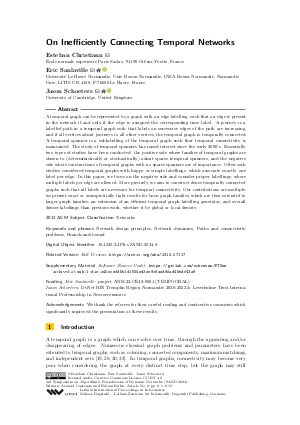LIPIcs.SAND.2024.8.pdf
- Filesize: 1.01 MB
- 19 pages

 Creative Commons Attribution 4.0 International license
Creative Commons Attribution 4.0 International license

A temporal graph can be represented by a graph with an edge labelling, such that an edge is present in the network if and only if the edge is assigned the corresponding time label. A journey is a labelled path in a temporal graph such that labels on successive edges of the path are increasing, and if all vertices admit journeys to all other vertices, the temporal graph is temporally connected. A temporal spanner is a sublabelling of the temporal graph such that temporal connectivity is maintained. The study of temporal spanners has raised interest since the early 2000’s. Essentially two types of studies have been conducted: the positive side where families of temporal graphs are shown to (deterministically or stochastically) admit sparse temporal spanners, and the negative side where constructions of temporal graphs with no sparse spanners are of importance. Often such studies considered temporal graphs with happy or simple labellings, which associate exactly one label per edge. In this paper, we focus on the negative side and consider proper labellings, where multiple labels per edge are allowed. More precisely, we aim to construct dense temporally connected graphs such that all labels are necessary for temporal connectivity. Our contributions are multiple: we present exact or asymptotically tight results for basic graph families, which are then extended to larger graph families; an extension of an efficient temporal graph labelling generator; and overall denser labellings than previous work, whether it be global or local density.





























Feedback for Dagstuhl Publishing